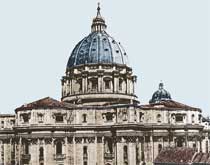St. Peter's Basilica
The foundation stone of the current Saint Peter's Basilica was laid in 1506. After other schemes had been commenced and abandoned, Bramante was appointed architect, and Giuliano da Sangallo, Raphael the painter, and Fra Giocondo of Verona, were afterwards associated with him in the work.
All four dying by 1520, Peruzzi was soon after appointed to control the works, although Antonio Sangallo the Younger had been previously (in 1518) made assistant to Raphael. Each architect on his appointment seems to have set himself to re-study the whole matter and produce his own plan, hence it is easy to account for the delays which occurred at this time; and with the successive removals of three Popes, the difficulty of procuring funds, and the sack of Rome, it is difficult to understand how the works at St. Peter's proceeded at all.

Saint Peter's Basilica
Vatican
St. Peter's Basilica designs
Bramante prepared many designs of the basilica. His definitive scheme was a cross, of four arms of equal length, the central feature of which was a low dome not far in form from that of the Pantheon. When architects and critics regret that Bramante's design was departed from, they should not forget that they have gained something greater than the dome with which he would have crowned St. Peter's.
After his death his whole scheme seems to have been put aside, and Raphael, possibly influenced by clerical conservatism, made an exceedingly beautiful and simple plan, in a more conventional form, a design which, says Serlio, "in my opinion, is one of the fairest draughts that are to be found, out of the which the ingenious workman may help himself in many things."
This plan, without any doubt, would have produced a finer building than that which now exists. It is often spoken of as Bramante's plan, but this is an error, although it may have been based upon the previous studies of Bramante and his assistants.
At Raphael's death, Peruzzi, appointed chief of works, found that the piers of Bramante needed great strengthening, having almost collapsed under their own weight; anxious, too, to restrict the scope of the work, and desiring to let the dome be seen from all points of view, he reverted to the Greek cross plan. The plan he adopted was really a skilful combination of the good points of the plans made by Bramante and Raphael. It seems a plausible theory that Raphael's eastern termination and Peruzzi's plan were based upon a study (perhaps by Bramante) of the ancient Church of San Lorenzo at Milan.
Peruzzi's annotator explains that St. Peter's Basilica was to have four doors, the high altar to occupy the middle. At the corners were to be four sacristies, upon which clock towers might be reared. Had this plan been implemented, there can be little doubt that it would have been not only the most magnificent temple the world had seen, but one of the purest in taste.
More on St. Peters's Basilica: